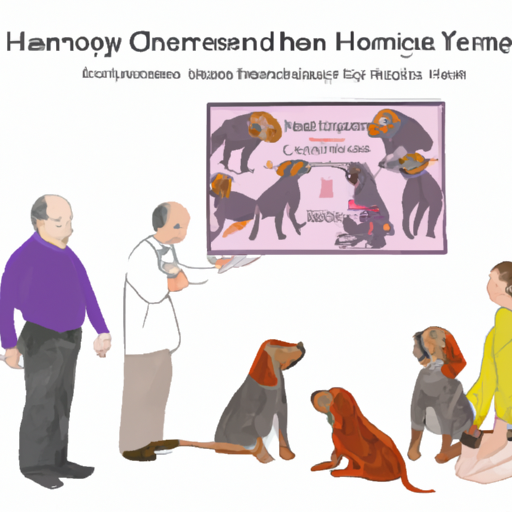As a dog owner or caregiver, understanding the progression of serious health conditions such as hemangiosarcoma can be crucial in providing the best care for your beloved pet. Hemangiosarcoma is a fast-spreading, aggressive form of cancer that predominantly affects dogs. In this article, we will delve into the end stages of this disease, discussing symptoms, prognosis, and how best to support your pet during this challenging time.
1. Understanding Hemangiosarcoma
Hemangiosarcoma is a form of cancer that develops from the cells that line blood vessels. The disease is often associated with the spleen, but it can also affect the heart, liver, skin, bone, and other organs. This cancer is particularly aggressive and tends to metastasize rapidly, often before it has even been diagnosed.
Breed, age, and gender are factors that can influence a dog’s risk of developing hemangiosarcoma. Breeds such as Golden Retrievers, German Shepherds, and Labradors have a higher incidence of the disease. Older dogs and males are also slightly more at risk.
2. Identifying Symptoms of Hemangiosarcoma
Detecting hemangiosarcoma in its early stages can be extremely challenging, as symptoms often do not present until the disease has progressed significantly. However, in the end stages of hemangiosarcoma, the following symptoms may be observed:
- Lethargy or fatigue
- Loss of appetite
- Weight loss
- Distended abdomen
- Difficulty breathing
- Pale gums
- Rapid heart rate
- Collapsing episodes
- Sudden death
3. Prognosis and Treatment Options
Unfortunately, by the time hemangiosarcoma is diagnosed, it has usually reached an advanced stage, and the prognosis is generally poor. The median survival time for dogs with untreated hemangiosarcoma is 19 to 86 days.
Treatment options typically include surgery, chemotherapy, and palliative care:
- Surgery: This is often the first line of treatment, aiming to remove as much of the tumor as possible. However, due to the aggressive nature of the disease, it is unlikely to cure the cancer.
- Chemotherapy: This can help slow the progression of the disease and improve the quality of life for a short period.
- Palliative care: In the end stages of the disease, the focus shifts to ensuring the dog is comfortable and free from pain.
| Treatment | Pros | Cons |
|---|---|---|
| Surgery | Can remove large portions of the tumor | Not a cure; invasive; risk of complications |
| Chemotherapy | Can slow disease progression | Side effects; not a cure |
| Palliative care | Focuses on comfort and quality of life | Does not treat the disease |
4. Supporting Your Pet in the End Stages of Hemangiosarcoma
In the end stages of hemangiosarcoma, it’s crucial to provide your dog with the right support:
- Comfort: Make sure your dog has a comfortable place to rest. If your dog is having difficulty moving, consider using supportive devices such as harnesses or slings.
- Nutrition: Providing a balanced, nutritious diet is critical. Your vet can recommend specific diets or supplements that may help.
- Pain management: Your vet can prescribe pain medication to help manage discomfort.
- Emotional support: Spend quality time with your pet. Your presence can provide tremendous comfort during this difficult time.
5. Preparing for the End
When the end is near, it’s essential to make plans that take into account your dog’s comfort and dignity. Consider having a discussion with your veterinarian about euthanasia, an act of compassion that can spare your pet unnecessary suffering.
Frequently Asked Questions (FAQs)
1. Can hemangiosarcoma be prevented?
Unfortunately, there is currently no known way to prevent hemangiosarcoma. Regular vet check-ups can help identify health issues before they become severe.
2. What breeds are most at risk of hemangiosarcoma?
Breeds such as Golden Retrievers, German Shepherds, and Labradors are more at risk, but no breed is immune.
3. How long can a dog live with hemangiosarcoma?
The survival time varies depending on the stage of the disease and the treatment provided. However, the prognosis for hemangiosarcoma is generally poor, with a median survival time of 19 to 86 days for untreated cases.
4. Can my dog be cured of hemangiosarcoma?
Due to the aggressive nature of the disease and the fact it is often diagnosed in the late stages, a cure is unlikely. However, treatment can help manage symptoms and improve quality of life for a period.
5. How can I best support my dog during this time?
Providing comfort, adequate nutrition, pain management, and emotional support can help manage your pet’s symptoms and enhance their quality of life during this challenging time.
Remember, as a caregiver, one of the most essential roles you can play is to offer your pet unconditional love and support during their battle with hemangiosarcoma. Every moment you share is precious, so cherish them and provide the best care possible for your furry friend.



